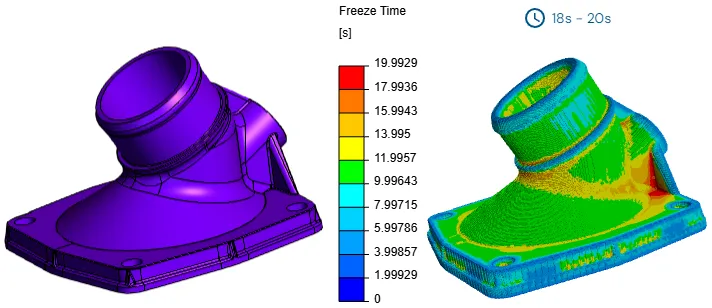by Sarra Zoghlami
Introduction
In the world of plastic mold design, achieving a balance between manufacturing high-quality components, that serve a given form or function, and optimizing production costs is a constant challenge. Cost estimators and mold designers are continually racing against the clock to meet the request for quotation (RFQ) deadlines. As cooling accounts for up to 80% of the cycle time, accurately estimating cooling times for parts is crucial to reduce financial risks and increase competitiveness.
SimForm Feasibility is a Design For Manufacturing (DFM) tool that helps you predict hot spots and areas in need of focused cooling, and estimate a good and achievable cooling time before the mold is even designed. This new tool also enables you to identify areas for design improvement, thus optimizing for manufacturing efficiency and improving overall part quality.
SimForm Feasibility Overview
With a SimForm Feasibility project, you upload a plastic part’s CAD file, and with only that, conduct mold cooling simulations. You gain insights into cooling time and can anticipate cooling challenges and risks, which helps you make more informed decisions.

Material selection significantly affects heat dissipation from plastic parts. You can rigorously test various mold and plastic part materials with Feasibility analyses, quantify the impact of each material on the part production cost, and optimize material choices for enhanced mold performance and superior part quality and affordability.
Efficiency is a cornerstone of SimForm. Using cloud-based GPUs and automated meshing, simulation times are reduced to minutes without compromising reliability, and you do not require any simulation knowledge to gain valuable insights. This approach supports iterative design processes, reducing project lead times and enhancing productivity.
Applications for Different Teams
In the plastics molding industry, various teams, including part design, tool design, and production teams, can benefit from SimForm Feasibility.
As a procurement officer at a product OEM, you face challenges to determine reliable part cost estimates. With different experts and suppliers providing varying numbers based on experience, it becomes difficult to make accurate business decisions and forecasts. SimForm provides valuable insights into design features that drive cooling time and part quality. By basing business decisions on reliable data from feasibility analyses, you reduce the risk of late part cost changes and identify opportunities for part changes that significantly reduce the manufacturing cost of your product without reducing its quality.
As tooling engineer or project manager, you often struggle with outsourcing mold designs and guiding mold designers to meet your standards and lead times. The shortage of experienced designers amplifies these challenges. SimForm’s Feasibility Project lets you, within minutes, locate the hotspots on the part for mold designers to address, without relying on lengthy, complex simulations. This reduces design iterations, and hence the development lead time. It helps you ensure that mold designers reach the desired part quality standards with minimal iterations and develop better molds faster.
As a cost estimator at a molder, having accurate cycle time estimates when answering an RFQ is crucial. The lack of reliable tools and the uncertainty of obtaining quotes from suppliers complicate this process. SimForm’s Feasibility Project lets you estimate the cooling time of any part within minutes. It also allows you to anticipate potential problem areas and use scientific data to recommend part design changes to your client that will improve the overall part quality. This valuable feedback helps you make informed decisions, increasing confidence and reducing the risk of cost increases downstream.
Conclusion
SimForm’s Feasibility Project lets you optimize plastic part and mold design processes. By providing accurate cooling time estimates, guiding design choices, and optimizing collaboration between the tool design, molder and part design teams, this innovative solution helps you make data-driven decisions and streamline production processes. Use SimForm’s Feasibility project to reshape your part and mold design practices and gain precise, efficient and competitive advantages in the plastic molding industry.